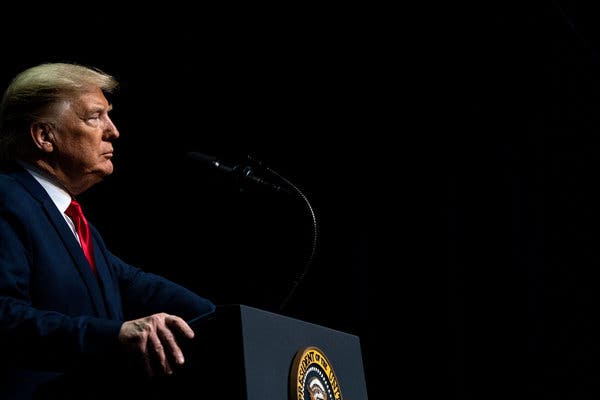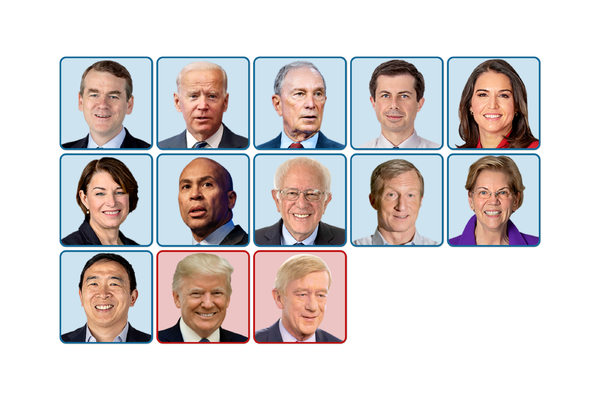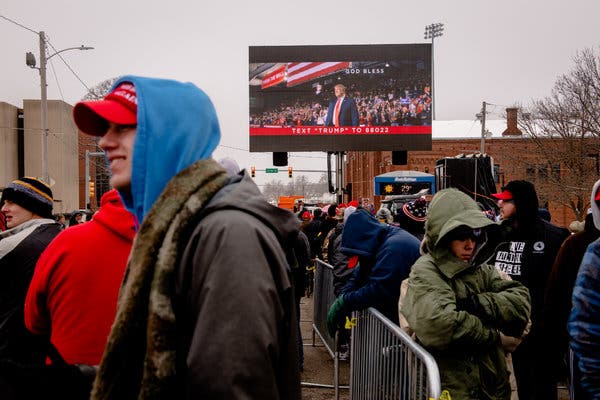Advertisement
With impeachment behind the president, his re-election campaign wants to address political weaknesses exacerbated by his policies and behavior.

WASHINGTON — Buoyed by his impeachment acquittal and the muddled Democratic primary race, President Trump and his campaign are turning to address his re-election bid’s greatest weaknesses with an aggressive, well-funded but uncertain effort to win back suburban voters turned off by his policies and behavior.
His campaign is aiming to regain these voters in battleground states like Pennsylvania and Michigan, after losing many of them to Democrats in the 2018 midterms. Advisers hope to expand the electoral map for November by winning moderate-leaning states like Minnesota and New Hampshire. And the White House is gearing up to help with policy issues directed at swing states, such as the new trade deal with Mexico and Canada and paid family leave for federal workers.
Trump campaign officials are also stockpiling cash to help with these efforts, with $200 million in the bank now and fund-raising continuing at a brisk pace. They have put up television ads relatively early in the race, allocating $6 million for the final three months of 2019 to highlight a booming economy and the low unemployment numbers.
Among the goals is trying to appeal to black voters and suburban and upper-income white voters with ads such as a spot focusing on criminal justice reform that first aired during the Super Bowl and is continuing on cable channels with large female audiences, like Bravo and Lifetime.
Yet Mr. Trump’s messaging, like so much else about his approach to politics, is contradictory. For all the focus on appealing to moderates, the campaign is also engaging the president’s hard-core supporters with Facebook ads warning of the danger of undocumented “aliens” and their “invasion” of the U.S., and decrying “the impeachment hoax,” while also promoting polarizing policies like curtailing immigration.
Those inflammatory, targeted ads are ones that suburban voters may never see, a reflection of the campaign’s broad strategy: Keep his conservative base energized and chip away at his problems in the suburbs and communities of color.
The challenge facing Mr. Trump’s advisers remains the same as it has been since 2017: The president is among the most deeply divisive leaders in the nation’s history, whose conduct has helped accelerate a realignment of moderate suburban voters toward Democrats. These voters have been the cornerstone of Democrats’ electoral revival since 2016, helping them flip governorships and propelling their capture of the House.
Mr. Trump cannot win a second term without winning back suburban voters and independents in a handful of states he carried in 2016. But he is highly averse to staying on script and delivering a consistent message aimed at moderate voters rather than his hard-core admirers, or his own need to get things off his chest.
Mr. Trump’s advisers argue that the suburban voters who eschewed Republicans in the 2018 midterms will vote differently when the president’s name is on the ballot. And they are lacing the strong economy into much of their messaging and policy plans: Mr. Trump himself sees the economy as his calling card and is monitoring fluctuations in stock market closely, and his team thinks the economy is one of their best selling points in the suburbs.
“Suburban women is where he has a challenge,” said Senator Kevin Cramer, Republican from North Dakota.
“I think the biggest problem that he has with suburban women is the part that so many in his base like about him,” Mr. Cramer said. “His rhetoric, his punching down at his opponents. It’s so different than anything they’ve seen.”
Scott Reed, the top political adviser to the U.S. Chamber of Commerce, nodded to the fleeting nature of Trump-era politics as he assessed the electoral landscape for the president.
“Politics in Trumpville are great right now, but these days, a week feels like three months and we have a long way to go,” Mr. Reed said.
Republican National Committee officials are tracking the suburban problem. In 2016, about 100,000 Michigan residents who voted in state legislative races left the box for president empty. Many of those voters were men in the suburbs, R.N.C. officials said, and were people who didn’t believe Mr. Trump was truly a conservative, but who have come back after seeing him deliver on conservative judicial appointments and a tax-cut bill.
But suburban women remain difficult to sway, Trump advisers acknowledge. Some messages have moved the dial, if only temporarily: When Mr. Trump talks about Democrats wanting to provide government health care benefits to undocumented immigrants, for instance, Republican officials have seen an uptick of support in their own surveys of the suburbs of Pennsylvania. When Mr. Trump paints the entire Democratic field, falsely, as supporting ending private health insurance, his advisers see room for him to grow. But they admit that it’s a difficult line to walk.
The G.O.P. strategy ultimately depends on who his Democratic opponent turns out to be. And Mr. Trump faces an unknown in Michael R. Bloomberg, a billionaire former New York City mayor running a general election strategy, who is spending so much money that Mr. Trump’s advisers acknowledged that he cannot be ignored even if Mr. Bloomberg loses the Democratic nomination.

The field of Democratic presidential candidates has been historically large. Here’s who’s in and who’s out.
With the Democrats enmeshed in the start of their primary season, Mr. Trump is beginning his own new phase: He has reasons to feel reassured about his prospects as he turns more fully to his re-election effort, and the apparatus of the White House and the Republican Party are more able to focus on winning him a second term.
Mr. Trump’s approval ratings have inched up and he’s now around where the last three incumbent presidents were at the start of their own, successful, re-elections. And the economy shows no signs of slowing.
“The White House and the campaign should focus 100 percent on the economic growth and opportunity society Trump is creating for America,” Mr. Reed said, somewhat hopefully.
But greater confidence and a freer hand can lead Mr. Trump to take risks: His phone call with the Ukrainian president on July 25, 2019, which ultimately helped lead to his impeachment in the House, came after he had seen the end of the two-year investigation by the special counsel, Robert S. Mueller III. Just this past week, Mr. Trump fired from the White House two witnesses and an ambassador who testified in the House impeachment inquiry, including Lt. Col. Alexander Vindman, a decorated war veteran, prompting outrage from Democrats and private concern among some Republican lawmakers. On Saturday, he tweeted that Colonel Vindman had earned his dismissal.
As Mr. Trump has repeatedly shown, he can show a measure of discipline in one moment — like his teleprompter-ready speech at the State of the Union that was sprinkled with appeals to different demographic groups — and then do or say something that alienates swing voters.
His 62-minute stemwinder of retribution in the East Room of the White House the day after the acquittal was the type of ventilating performance Mr. Trump had been craving, but which some advisers acknowledge undermines the carefully-crafted efforts at broadening his appeal.
“Many people are evaluating the president based on his conduct and behavior in office rather than the state of the economy,” said Whit Ayres, a longtime Republican pollster. “It’s his conduct and behavior in office that have kept a foot on his job approval rating. Any other president would be in the upper 50s or even low 60s with this economy.”
Most of the president’s aides concede that his base of supporters is not enough to re-elect him, and that he must attract the voters who were repelled by his behavior and voted against Republicans in the 2018 midterms — particularly upscale whites, suburban women and self-described independent voters who polls repeatedly show think the president is racist, or has a troubling temperament, or both.
To that end, the president’s campaign aired a Super Bowl ad featuring Alice Johnson, a black woman convicted on charges related to drug trafficking whose sentence the president commuted. The president also awarded an “Opportunity Zone” scholarship to a young African-American girl during his State of the Union address, and tailored other moments during the speech to appeal to members of the military.
Trump advisers are focused not just on the three states that elected Mr. Trump in 2016 — Wisconsin, Michigan and Pennsylvania — but also the forever battleground of Florida, and battleground states with competitive Senate races that could help the Democratic nominee in Georgia, Arizona and North Carolina.
The campaign also sees opportunities for pickups in New Hampshire and especially in Minnesota, states that have voted for Democrats in recent presidential races but where the margins were close in 2016. But while the campaign manager Brad Parscale has insisted New Mexico is within reach, other Trump advisers say there’s been little movement, in part because of the president’s disinterest in taking the day trips he favors to the western part of the country.
In an interview, Ronna McDaniel, the chairwoman of the R.N.C., said they have the resources to appeal to multiple groups of voters. “That gives us an advantage to focus on the rural vote that we need to turn out, but then also go after places where we’ve lost voters to bring them back in,” she said. And Tim Murtaugh, a campaign spokesman, said they had always planned to woo various demographics, “regardless of what Democrats in Congress were trying to do to him.”
The administration is pulling out the policy stops. Vice President Mike Pence has recently made stops and bus tours in Wisconsin and Pennsylvania, highlighting Trump administration efforts like the “school choice” initiative to help low-income students enter private schools.
On Thursday, Mr. Trump tweeted that he was looking to move away from a proposal pushed by his former energy secretary, Rick Perry: storing nuclear waste in Nevada’s Yucca Mountain, an effort his two top political advisers, Bill Stepien and Justin Clark, opposed for years. And officials are expected to hold events in the Midwest highlighting provisions aimed at helping domestic automakers that were included in the U.S.M.C.A. trade deal.
“We’ve been chopping wood for a while, and it feels like everyone else is seeing what we’ve been seeing for a long time,” said Jared Kushner, the president’s son-in-law who is overseeing his campaign. “Everyone else has been distracted, but it’s not like we invented these policies for the State of the Union.”
What’s unclear, and what could prove decisive, is whether the country is exhausted by Mr. Trump and is ready for a so-called return to normalcy, or if voters have grown inured to his eruptions and have effectively priced in his behavior.
A key factor will be the candidate the Democrats eventually nominate. Interviews with more than a dozen Republican strategists, lawmakers and state chairs reveal a consensus that Senator Bernie Sanders would be the easiest Democrat for them to beat because they believe his avowed socialism would help them reclaim suburbanites and better frame the election as a choice.
“It’s easy to call him a socialist because he admits it,” said Tim Pawlenty, the former Minnesota governor. “At least Warren tries to deny it.”
Mr. Sanders’s aides, of course, see it very differently and believe that they would tear up Mr. Trump’s 2016 electoral map by reclaiming working-class white voters in states like Michigan and Wisconsin, something some Trump advisers agree with. And Trump advisers have been caught by surprise by the success of Pete Buttigieg, the former mayor of South Bend, Ind.
“We don’t have a Democratic opponent yet,” said Mr. Cramer. “It’s always harder to run against the unnamed opponent. Once you have the opponent, you get to draw the distinctions.”
-
- With Joe Biden’s setback in Iowa, the Democratic Party has been left to consider an unsettling truth: There is no safe option.
-
- Pete Buttigieg and Bernie Sanders are separated by less than one-tenth of a percentage point in the Iowa caucus results. See the latest results here.
-
- The muddled Iowa caucuses set in motion a tough new series of tests for the top candidates that may come to a head in New Hampshire.
-
- Learn more about the top-polling Democratic presidential contenders.
-


